Synchron-Libraries-Audio-Demos
- English
- Deutsch
Important information

To make an audio mix as transparent as possible, it is important to place instruments as ideally as possible - also in the depth of the room. That's why I always create a sketch of where each orchestral instrument should play before mixing. I then try to realize this sketch acoustically.
For the following audio examples, I created beautiful plans so that you can compare the mix and my graphic specifications.
Have fun with the demos.

Depending on the speaker situation (LapTop, Desktop...) I recommend good headphones to hear the details of the mixes well.
Hora Staccato, Grigoras Dinicu

Grigoraș Dinicu (1889-1948) was a Romanian composer whom Jascha Heifetz apparently once described as the best violinist he had ever heard.
He worked as a violinist in various orchestras and conductor. But he played in hotels and restaurants as well. He also composed, most of the pieces for violin and piano. His works contain many elements of Romanian folk and gypsy music, including the piece HORA STACCATO, which was to become one of his best-known pieces.
Photo from Wikipedia
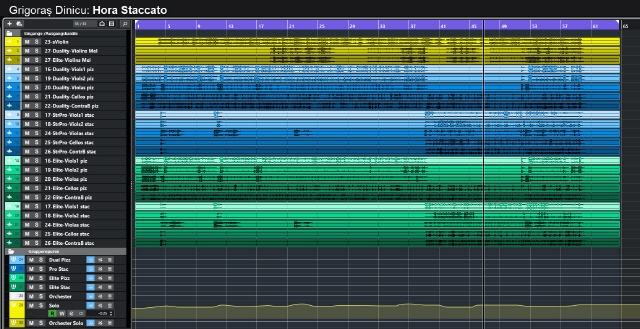
The piece HORA STACCATO is driven by a rhythm that is typical of Romanian folk music. As if this accompaniment didn't provide enough steam, the melody is laid over it with many 16th notes. Accordingly, orchestras and violinists can compete with this piece to see who can play the whole thing a little faster. One of the fastest recordings I found on YouTube is that of the "Orchestra Lautarri".
You can see the libraries used from the picture next to it...
A few notes on the production

A) It is somewhat difficult to ensure that the whole thing doesn't sound mechanical. The first thing you have to do is allow slight tempo fluctuations to flow in despite the driving rhythm so that everything has a natural flow. I synchronised the tempo of the midi file to a real recording. Both now play at the same speed.
B) Furthermore, with such fast and short notes you should always select the velocity by the keys and not by a "VelXF" -curve. This allows you to control the volume of each 16th note individually, as is the case in real life.
C) Then, in various Youtub videos, I liked it when the whole ensemble plays the fast-paced melody as well. So I alternated between the solo violin and the ensemble. I chose the Duality Strings as the main ensemble library, lightly assisted by the Elite Strings. Because the solo violin also plays with the ensemble, I was able to achieve an interesting "multi-string effect".
D) Frequently changing the articulations is a matter of course for me. Even though the notes are almost always 16th notes, some of them can be played with sfz, for example, to set certain accents. Setting the trills was also a big job. By the way: It is always amazing how quickly the SYNCHRON player reacts.
More in the video...
Hora Staccato (sViolin = synch-ized version)

A click on the picture will take you to Youtube, where you can watch a video on the above topics...
Here you can download the MIDI-File [23 KB]
that led to the sheet music.
(pure notes, without trills)
Click here for the PDF-Score [1’138 KB]
(differs slightly from the final sound in some bars)
Grigoras Dinicu, Hora Martisorolui

This is another piece by Grigoraș Dinicu. The arrangement is made by me. However, I was inspired by the tempo and the ideas from the performance by PANFILI & FRIENDS (Youtube). To give the whole thing an even better live character, I used Rusanda Panfili's counting of the piece. When I asked if I could use her scoring, she didn't reply. I assume that it is OK.
Another special thing about this performance is that I used the Synchron Solo Violin (2024) for the first time. You can hear that it can react and play very agilely. The tempo causes the library little trouble. One advantage over the solo violin from the Silent Stage is certainly that with the many microphones (including room microphones) the instrument can be better adapted to a wide variety of situations and musical styles.
Hora Martisorului (Synchron Solo Violin)
Schenkt man sich Rosen in Tirol
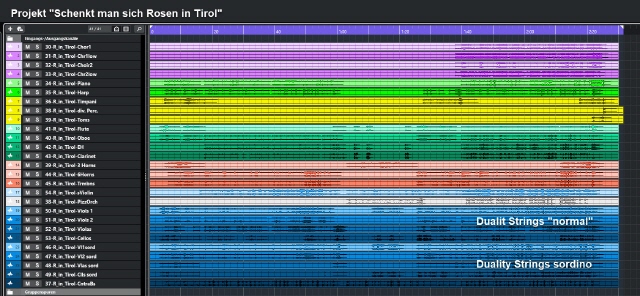
This piece is from the opera "Der Vogelhändler (1891)" by Carl Zeller (1842-1898). My arrangement is close to the version André Rieu plays with his violin. I used two Duality Strings orchestras to be able to realize all the string parts.

Orchestra 1 (left) tends to play slightly lower voices. I chose the Sordino - sound for this. This has the advantage that the solo violin, which I also positioned more to the left, is not covered in the sound.
Orchestra 2 (right) tends to play voices in the high range and without Sordinos. This combination together with the solo violin on the left produces a beautiful stereo sound.
Double basses play the bass for both orchestras (1 and 2). They are positioned in the middle - ideal for the mix anyway.
Below you can hear how the strings sound on their own and then the complete mix:
Schenkt man sich... (only the Duality Strings)
Possible Full-Mix (SYNCHRON Violin)
Pirates of the Caribbean
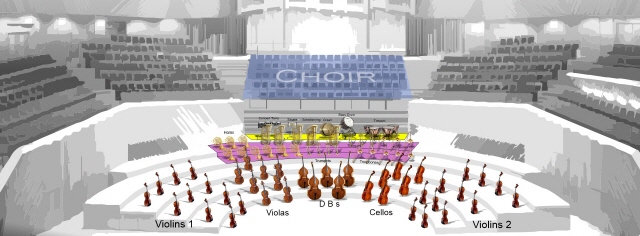
This audio demo is to show once more that with the SYNCHRON player libraries neither MIR nor other tools are necessary to place the different instruments in the room. The graphic opposite shows that in the front of the stage the strings should play and in the back of the concert hall the brass. Also in the back the percussion and a choir. so nothing special - actually the same as always. How do you solve the thing with the depth of the room and instruments?
Trumpets

If you want to set the position in the room yourself, it is advantageous to select the mixer preset "DEFAULT" in the mixer of the SYNCHRON player. After that you can adjust the position in the room depth of the concerning instrument with the help of the different microphone signals. If you select only the ROOM microphone signal (Mix of all room signals, done by VSL), you will hear, for example, the trumpets playing far back in the SYNCHRON-stage. If you add "MID" and "CLOSE", the trumpet sound gets closer and closer. If you want the trumpets to be very close, reduce the amount of the room microphone completely.
This is the trumpet sound (6 trumpets) as it sounds with the current mixer setting on the right:
Brass-Sound (VSL Brass Library)
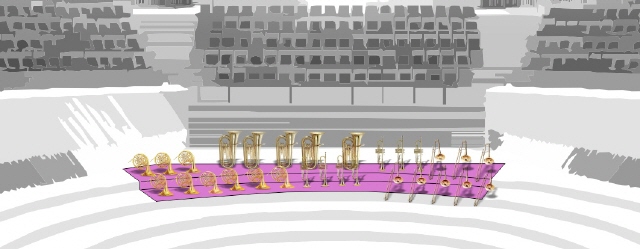
If you set the position of all brass instruments in this way, it sounds like in the next example. Attention: Except for the mix settings in the SYNCHRON mixer, the sound comes like this from the SYNCHRON-Player instances. So no mix effects so far! However, the individual instruments are normalized so that they all sound with the same volume. Basically trumpets, horns, trombones and tubas appear here. There are no other wind instruments.
Strings sound (VSL Duality Strings)

The strings play in the foreground. You can't push them as far back as the brass - even if you only choose the room mics. The Strings were closer to the "room mics" during the SYNCHRON stage recordings. After all, we want the strings to sound front anyway. By the way, here too: The sound is without any effect: pure VSL-SYNCHRON Stage.
...and a possible Final Mix
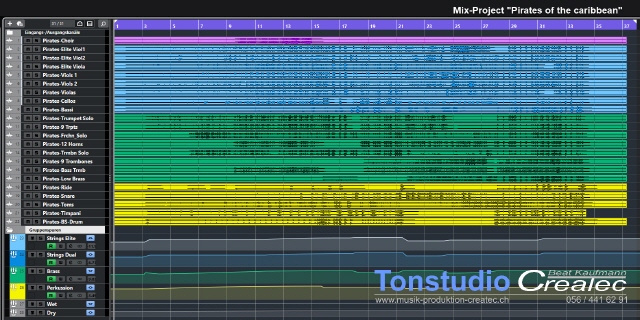
You can mix these samples (audio files) yourself. For this purpose, the audio files of the instruments are available for download under "Work-Files/Pirates of the Carribean"!
Beethoven, Symphony No. 9, Presto

This demo shows the bass section of the Duality Strings library. As a template I took a recording of the Chicago Symphony Orchestra, conducted by Ricardo Muti 2014, from Youtube.
Since it is a larger orchestral instrumentation, it was mainly the A orchestra that was used. Unlike Ricardo Muti, I chose to have the violins 1 on the left, but the violins 2 on the right, the violas in the center left, the cellos in the center right, and the double basses in the center. This makes the stereo image a bit more balanced (See Orchestra Layout below).

Instead of doubling the library with Section B, I used the Elite Celli and Bassi. However, I mixed them in so little that you hardly hear a difference with or without. The violas and the two violins did not get any doubling because they have almost no significant contribution to make in the excerpt shown anyway.

On the right my orchestra setup.
If you want, you can read the notes here: beethoven_nr9_presto.pdf [909 KB]
Have fun...
Beethoven_Symphony_no_9_exc-Duality_Strings
Brahms, Hungarian Dance Nr.5
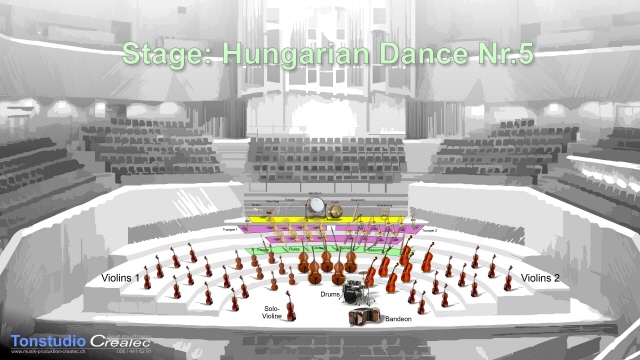
I recorded this orchestral piece to show the reverb concept I usually use when mixing samples. So the main point is to show, with a slightly larger instrumentation, that the depth of the instruments can indeed make a mix seem more transparent. In addition, with my mixing concept, the music only gets a reverb tail once and not every single instrument as in other mixing concepts, which usually leads to a "thicker" mix. Therefore I recommend to read the reverb concept chapter of this Hungarian Dance No.5 as well.
Some more info:

The whole audio tracks are available as download under Work - Files .
So you can try out my mixing concept yourself. The positions of the instruments are largely given. So it's just a matter of bringing out the individual instruments nicely and at the end "flavoring" the mix with a reverb tail to your own taste. So that the piece does not become too long, I have rearranged Mr. Brahms somewhat. I hope he is not angry with me.
There are the following sections playing in different depths of space:
- Percussion / - Brass / - Woodwinds / - Strings / - Solo instruments, which do not always play solo.
And this is a possible mix:
Hungarian Dance Nr.5 (Brahms), arr. B. Kaufmann
Alphorn meets G.F. Handel
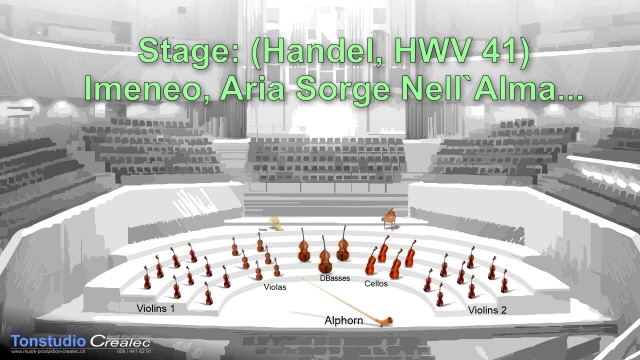
Recently I had the pleasure of recording an alphorn, together with a wind ensemble. Inspired by this, I decided to realize a not everyday situation with samples. Here in Switzerland, the alphorn is more at home in folk music. And because the alphorn can play "only" a limited number of naturals, its sound is known mainly from hunting horn-like pieces of music.
That's why I chose a baroque piece by Händel, which should contain playable passages. Likewise, the piece should have some "steam" in terms of speed, since the alphorn is known mainly from slow and sustained music pieces.
Some more info:
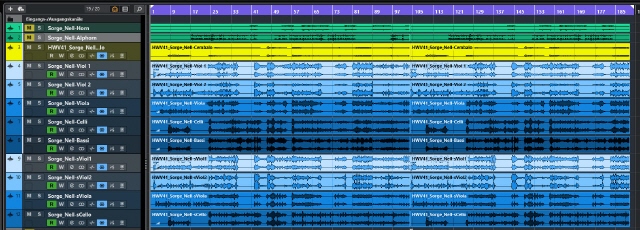
Because the alphorn - as mentioned - cannot play all notes, I gave it a French Horn to play beside it.
From time to time, it plays sections as support that lie outside the alphorn range. A great addition, in my opinion.
Nevertheless, I had to adapt the melody of the alphorn to its possibilities from time to time, so leaving Handel's melody line.
I chose the aria "Sorge Nell' Alma... [1’530 KB]
" from the opera Imeneo (HWV41). The tempo is around 156-160 bpm.

As Alphorn library I used the one from Sonokinetic. In order to distinguish between alphorn and frenchhorn, I let the alphorn play in the front (solo) and the frenchhorn more distant, in the back left. Unfortunately the library is not of very good quality. The string orchestra is mainly performed by the Elite Strings. The extremely fast playing style requires mainly the short staccati (agile). Once again, the great precision of the VSL libraries comes into its own. No matter which tone you choose, there are no unwanted delays or other errors due to the speed.
As you can see in the mixing project (image above), I have supplemented the Elite Strings (violins and viola) with the Studio Solo Strings. The small, imprecise differences give the orchestra an incredible note of authenticity. Quite different from when only one library is playing. Great!
HWV41 Handel, Imeneo with Alphorm
Only the playback strings (Elite+Studio Solo Str)
If you like, you can recreate the mix yourself. The audio files are available here...
O Waly Waly, Thin Whistle Demo

"The Water Is Wide" (also called "O Waly, Waly" or simply "Waly, Waly") is a folk song of Scottish origin (Wikipedia). The Composer is unknown but Cecil Sharp (an English-born folk song collector, musician and composer) published the song in "Folk Songs From Somerset (1906)".
Tin whistles, also called penny whistles due to their affordable price, originated in the 19th century in Great Britain and Ireland. The six-holed woodwind instruments are especially popular in Irish, Scottish and Celtic music (Text VSL).
Some more info:

Orchestration: Beat Kaufmann
Except for the solo and percussion instruments, I used only legato articulation. I achieved the dynamics with the controllers CC11, the xVelocity and as additional help (especially with the wind instruments) CC08 (Timbre Adjust). For all samples I used exclusively the preset "DEFAULT". The current version is played with the Duality Strings paired with the solo strings violin 1+2.

Besides the untreated SYNCHRON stage sound, these "default sounds" allowed me to adjust the positions of all instruments on the virtual mix stage. I only achieved this with the different microphone ratios and the corresponding Power Panner in each SYNCHRON player. In the following audio mix I was able to create further dynamic differences.
Download: VSL-Tin-Whistle-Demo-Info.pdf [2’943 KB]
Traditional, Fujara-Flute Demo
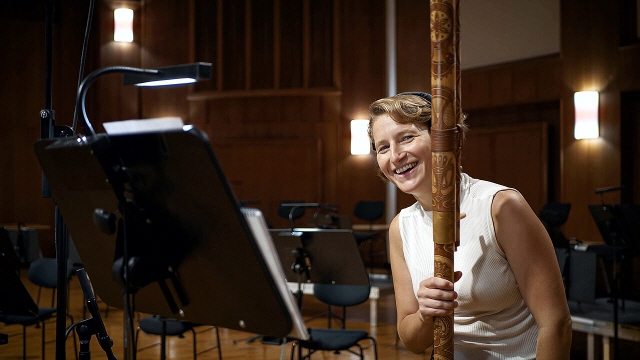
Orchestration: Beat Kaufmann
This piece features the "Free VSL instrument" - the FUJARA flute. I chose an old Swiss folk song: The Guggisberglied. It is about a girl (Vreneli) on an alp on the Guggisberg who loves Hans-Jakob on another alp on the Simeliberg. For reasons not mentioned, they cannot come together. The melody is therefore rather sad (in a minor key). The fact that the "fujara flute" is also used by shepherds and that the sound of the flute is quite suitable for sad melodies makes the instrument sound in its very own splendour.

The fujara flute plays partly in echo with a piccolo, as if Vreneli and Hans-Jakob were communicating with each other. The distant sounding piccolo is meant to symbolise the great distance between the lovers.
The mix is also meant to show that distances can create interesting contrasts in the depth of the mix. Different spatial depths are therefore an interesting and rather little used design element.
G. F. Handel, Organ Concerto in F, HWV295
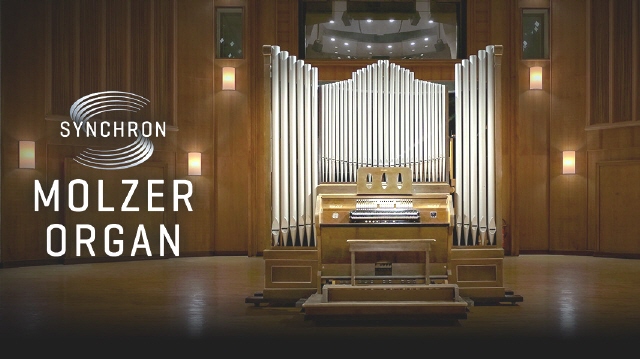
An audio demo of the Molzer Organ. This wonderful salon organ was recorded in the large Stage A of the Synchron Stage Vienna. It is the first time that a historical salon organ has been recorded in a large recording hall... I made use of this fact in the demo by mainly using the room microphone sound to make the organ appear acoustically behind the Elite Strings.

This arrangement gives the demo a sense of depth that seems very natural. For the Elite Strings, I used the mic signals more in favour of the close mics. I "flavoured" the whole thing with a bit of tail-over-all.
Some more Info: VSL-Molzer_Organ-Demo-Info-Document.pdf [427 KB]
C. Jenkins, Benetictus (Excerpt)

This is a demo from the tutorial "Mixing an Orchestra".
The task there is to have the strings and choir play far enough away so that the solo cello stands out beautifully in the foreground.
This demo (my solution to the task) can be heard here because the Synchron Strings libraries sound wonderful even when they have to play very softly. Here is a combination of Synchron Strings Pro and the Elite Strings. ... together with Cello 1 (from the synchronized Silentstage library) and a choir out of Cubase.
G.F. Handel, Excelsus Super Omnes
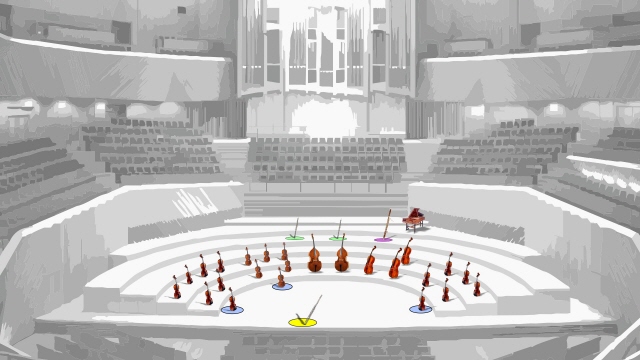
This is another demo showing the Synchron Woodwinds instruments in action. The piece is originally a soprano aria from the complete work Laudate Pueri Dominum by G.F. Handel.
It is perfect for introducing the two oboes, the later added "Bassoon 2" and also the later appeared "Flute 2". Where the instruments are to play on stage, everything is set in the respective Synchron Player. An appropriate combination of the various microphone signals and the panner. So it happens that here the flute 2 plays as a solo instrument in front and the other woodwind instruments behind the strings.
Everything together is "spiced" with some reverb.
J.S. Bach, Air on a G-String (modern style)

I recorded this demo to show how to dynamically process VSL samples. This is undeniably a very important process if you want to "make music" with samples, isn't it?
There is a video for this demo where you can learn more about the topic.
See the video about it: https://youtu.be/-ApLqr6Uyyk?t=247
Listen to how the piece gradually "works its way up" to the culmination point (at around 03:05) and then calms down again until the end. Emotional and not at all "sample-typical"!
This is music, isn't it? (with just quite a bit of effort - see video)
W.A. Mozart, Eine kleine Nachtmusik

This demo shows the new sample libraries "Synchron Elite Strings" and "Synchron Strings Pro". The two libraries play in unison, whereby the "Synchron Strings Pro" is only mixed in to a small extent. This results in an altogether fresh string sound. Wherever possible, "agile" samples were used here. This is noticeable in the fact that the short demo does not sound static at any time.
A 2nd mix with the Elite + Solo Strings.
Elite Strings + StringsPro
Elite Strings + Solo Strings
E. Grieg, Holbergsuite
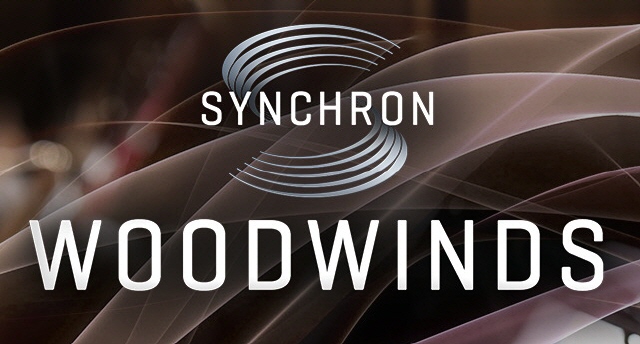
As is generally known, the Holbersuite is written for string orchestra. I arranged it this way so that I could show the new Synchron Woodwindlibrary. So it is therefore a Synchron Woodwind Library demo. A bit special perhaps, but the demo shows how agile the individual instruments can play.
See the video about it: https://youtu.be/CJAnqpJHSb4
J. Sibelius, Finlandia

Another "Synchron Woodwinds" demo. In the first run, the Woodwinds solo instruments play high, an octave higher than usual. In the second run, the Woodwind ensembles (3 instruments each) join in and play in normal tuning - together with the violins. In the last part, the brass instruments join in, so that everything becomes a symphonic sound.
See the video about it: https://youtu.be/KmYIdt9rgR4
Note on the audio demos:
I didn't use "Vienna Mix Presets" for any of the demos, but a mix of the various microphones on the Synchron Stage. The "DEFAULT" preset (no effects, just the pure microphone signals) was always used as the starting point. I adjusted the spatial depth of the instruments with the various microphone signals and their position with the panner. This meant that there was no additional panning required in the mix and no addititional room depth to move instruments in the room depth. The only thing left to do was to add a reverb tail. So you always hear the pure "SYNCHRON stage sound". Furthermore, for mixing reasons, I always used the string layout in the picture above.
Wichtige Information

Damit ein Audiomix möglichst transparent wird, ist es wichtig, Instrumente möglichst ideal zu platzieren - auch in der Raumtiefe. Deshalb erstelle ich vor dem Mischen immer eine Skizze, wo welche Orchesterinstrumente spielen sollen. Diese Skizze versuche ich danach akustisch umzusetzen.
Für die nachfolgenden Audiobeispiele erstellte ich schöne Pläne, damit Sie jeweils den Mix und meine grafische Vorgabe vergleichen können.
Viel Spass mit den Demos.

Je nach Lautsprechersituation (LapTop, Desktop...) empfehle ich gute Kopfhörer, um die Details der Abmischungen gut zu hören.
Hora Staccato, Grigoras Dinicu

Grigoraș Dinicu (1889-1948) war ein rumänischer Komponist, den Jascha Heifetz offenbar einmal als den beesten Geiger bezeichnete, den er je gehört hatte.
Er arbeitete als Violinist in verschiedenen Orchestern und Dirigent. Er spielte aber auch in Hotels und Restaurants. Er komponierte auch, die meisten Stücke für Violine und Klavier. Seine Werke enthalten viele Elemente der rumänischen Volks- und Zigeunermusik, so auch das Stück HORA STACCATO, was eines seiner bekanntesten Stücke werden sollte.
Foto von Wikipedia

Das Stück HORA STACCATO wird von einem Rhythmus angetrieben, der thypisch für die rumänische Folksmusik ist. Als ob diese Begleitung nicht genug Dampf liefert, wird die Melodie mit vielen 16teln darüber gelegt. Entsprechend können sich mit diesem Stück Orchester und Geiger messen, wer vielleicht das Ganze doch noch etwas schneller spielen kann. Eine der schnellsten Einspielungen, welche ich auf Youtube fand, ist jene vom "Orchestra Lautarri".
Vom Bild nebenan können Sie die verwendeten Libraries entnehmen...
Ein paar Hinweise zur Herstellung

A) Etwas schwierig ist zu erreichen, dass das Ganze nicht mechanisch klingt. Als erstes muss man deshalb trotz dem treibenden Rhythmus leichte Temposchwankungen einfliessen lassen, damit alles einen natürlichen Fluss bekommt. Ich synchronisierte das Tempo des Midifiles zu einer echten Einspielung. Beides spielt nun gleich schnell.
B) Weiter sollte man bei solch schnellen und kurzen Noten auf jeden Fall die Velocity per Key-Anschlag wählen und nicht per "VelXF" - also nicht per Kurve. So kann man jede 16tel-Note einzeln in der Lautstärke steuern, wie dies ja in echt auch der Fall ist.
C) Dann gefiel mir bei verschiedenen Youtub-Videos, wenn das ganze Ensemble die rasante Melodie spielt. So liess auch ich die Solovioline und das Ensemble abwechseln. Als Ensemble-Hauptlibrary wählte ich die Duality Strings, leicht assistiert durch die Elite-Strings. Weil die Solo-Violine auch beim Ensemble mitspielt konnte ich einen interessanten "Multi-String-Effekt" erreichen.
D) Ein häufiges Wechseln der Artikulationen gehört bei mir zur Selbstverständlichkeit. Auch wenn es sich fast immer um 16tel-Noten handelt, können einzelne davon z.B. mit sfz gespielt werden, um gewisse Akzente zu setzen. Ein grosse Arbeit war auch die Triller zu setzen. Dabei ist immer wieder erstaunlich, wie schnell der SYNCHRON-Player reagiert.
Mehr im Video...
Hora Staccato (sVioin = synch-ized version)

Ein Klick auf das Bild führt Sie zu Youtube, wo Sie das Video zur Herstellung von HORA STACCATO ansehen können...
Hier können Sie sich die MIDI-File [23 KB]
herunterladen, das zur Partitur führte.
(reine Noten, ohne Triller)
Klicken Sie hier für die PDF-Partitur [1’138 KB]
(weicht in einigen Takten leicht vom endgültigen Klang ab)
Grigoras Dinicu, Hora Martisorolui

Das ist ein anderes Stück von Grigoraș Dinicu. Das Arrangement ist von mir. Allerdings habe ich vom Tempo und von den Ideen aus der Performance von den PANFILI & FRIENDS (Youtube) inspirieren lassen. Um dem ganzen einen noch besseren Live-Charakter zukommen zu lassen verwendete ich das Einzählen des Stückes von Rusanda Panfili. Auf Anfrage, ob ich ihr Einzählen benutzen darf, antwortete sie nicht. Ich gehe davon aus, dass es OK ist.
Besonders ist wohl an dieser Perfomance auch, dass ich das erste Mal die Synchron Solo-Violine (2024) verwendete. Man hört, dass sie sehr auch sehr agil reagieren und spielen kann. Das Tempo bereitet der Library wenig Mühe. Ein Vorteil gegenüber der Solo Violine aus der Silent Stage ist sicher, dass mit den vielen Mikrofonen (auch Raummikrofone) das Instrument besser an verschiedenste Situationen und Nusikstile angepasst werden kann.
Hora Martisorului (Synchron Solo Violin)
Schenkt man sich Rosen in Tirol

Dieses Stück ist aus der Oper "Der Vogelhändler (1891)" von Carl Zeller (1842-1898). Mein Arrangement hält sich nahe an der Version, wie sie André Rieu spielt mit seiner Violine. Ich verwendete zwei Duality Strings-Orchester, um alle die Streicherstimmen realisieren zu können.

Orchester 1 (links) spielt eher etwas tiefere Stimmen. Ich wählte dafür den Sordinen-Klang. Das hat den Vorteil, das die Solovioline, welche ich auch eher links positionierte, im Klang nicht verdeckt wird.
Orchester 2 (rechts) spielt eher Stimmen im hohen Bereich und ohne Sordinos. Diese Kombination ergibt dann mit der Solo-Violine einen schönen Stereoklang.
Kontrabässe spielen den Bass für Orchester 1 und 2. Sie sind in der Mitte positioniert - für den Mix sowieso optimal.
Nachfolgend hören Sie, wie die Streicher alleine klingen und danach den kompletten Mix:
Schenkt man sich... (nur die Duality Strings)
Possible Full-Mix (SYNCHRON Violin)
Pirates of the Caribbean

Diese Audio-Demo soll einmal mehr zeigen, dass mit den SYNCHRON-Player-Libraries weder MIR noch andere Tools nötig sind, um die verschiedenen Instrumente im Raum zu platzieren. Die nebenstehende Grafik zeigt, dass im vorderen Bühnenbereich die Streicher spielen sollen und hinten im Konzertsaal die Blechbläser. Ebenfalls hinten die Perkussion und ein Chor. Nichts Besonderes - eigentlich wie immer. Wie löst man die Sache mit der Raumtiefe und Instrumenten?
Trumpets
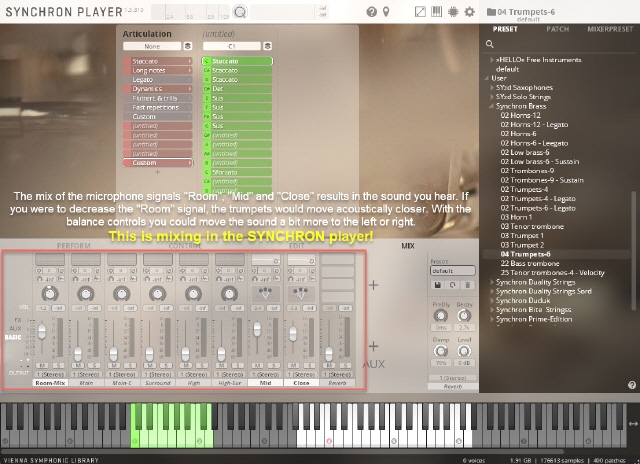
Wenn man die Position im Raum selber einstellen will, wählt man mit Vorteil das Mixer Preset "DEFAULT" im Mixer des SYNCHRON-Players. Danach können Sie mit Hilfe der verschiedenen Mikrofonsignale die Position in der Raumtiefe des betreffenden Instrumentes einstellen. Wählt man nur das ROOM-Mikrofonsignal (Mikrofon-Mix von VSL von allen Raumsignalen), hört man z.B. die Trompeten weit hinten in der Synchronstage spielen. Mischt man "MID" und "CLOSE" hinzu, rückt der Trompetensound zunehmend näher. Will man die Trompeten ganz nahe haben, reduziert man den Anteil vom Room-Mikrofon ganz. Nachfolgend der Trompeten Sound (6 Trumpets), wie er mit der aktuellen Mixereinstellung klingt:
Brass-Sound (Brass Library VSL)

Stellt man die Position aller Blechbläser auf diese Weise ein, tönt dies wie im nächsten Beispiel. Achtung: Ausser den Mixeinstellungen im SYNCHRON-Mixer kommt der Klang so aus den Synchron-Instanzen. Also bisher keine Mix-Effekte! Die einzelnen Instrumente sind allerdings normalisiert, damit alle gleich laut klingen. Im wesentlichen kommen hier Trompeten, Hörner, Posaunen und Tubas vor. Andere Bläser gibt es nicht.
Streichersound (Duality Strings)

Die Streicher spielen im Vordergrund. Diese kann man nicht so weit nach hinten schieben wie das Blech - auch wenn man nur die Room-Mikrofone wählt. Sie waren bei den Aufnahmen in der SYNCHRON-Stage näher an den "Raum-Mikrofonen". Wir wollen die Streicher ja ohnehin vorne klingend. Übrigens auch hier: Der Sound ist ohne jeglichen Effekt: SYNCHRON-Stage pur.
und ein möglicher Schlussmix...

Sie können diese Samples (Audiofiles) selber mischen. Dazu stehen die Audiofiles der Instrumente unter "Work-Files/Pirates of the Carribean" zum Download zur Verfügung!
Beethoven, Symphony No. 9, Presto
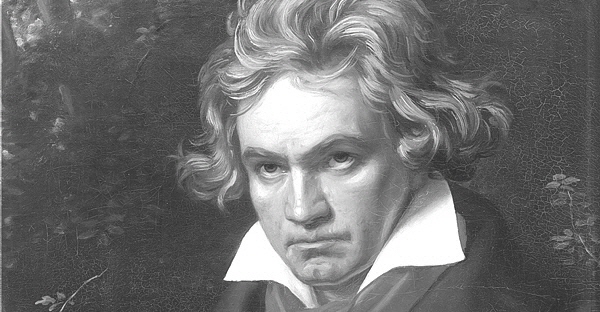
Diese Demo zeigt die Basssektion der Duality-Strings Library. Als Vorlage nahm ich eine Einspielung vom Chicago Sympony Orchestra, dirigiert von Ricardo Muti 2014, von Youtube.
Da es sich um eine grössere Orchesterbesetzung handelt, wurde vor allem das Orchester A eingesetzt. Anders als Ricardo Muti wählte ich zwar die Violinen 1 links, aber die Violinen 2 rechts, die Violen in der Mitte links, die Celli in der Mitte rechts und die Kontrabässe in der Mitte. Dadurch wird das Stereobild etwas ausgeglichener (Siehe unten Orchestra Layout).

Statt mit der Sektion B die Library zu doppeln, verwendete ich die Elite-Celli und Bassi. Ich mischte sie allerdings so wenig hinzu, dass man kaum einen Unterschied hört mit oder ohne. Die Violen und die beiden Violinen erhielten keine Doppelung, weil sie ohnehin fast keinen nennenswerten Beitrag leisten müssen in dem gezeigten Ausschnitt.

Rechts mein Orchester-Setup.
Wer will, kann hier die Noten mitlesen: beethoven_nr9_presto.pdf [909 KB]
Viel Spass...
Beethoven_Symphony_no_9_exc-Duality_Strings
Brahms, Ungarischer Tanz Nr.5

Dieses Orchesterstück spielte ich ein, um mein Hallkonzept zu zeigen, das ich normalerweise verwende, wenn ich Samples mische. Es geht also hauptsächlich darum, mit einer etwas grösseren Besetzung zu zeigen, dass die Tiefenstaffelung der Instrumente durchaus einen Mix transparenter erscheinen lässt. Zusätzlich bekommt bei meinem Mischkonzept die Musik nur einmal eine Hallfahne und nicht wie in anderen Mischkonzepten jedes einzelne Instrument, was in der Regel zu einem "dickeren" Mix führt. Deshalb empfehle ich, das Hallkonzeptkapitel zu diesem Hungarian Dance Nr.5 auch zu lesen.
Mehr Informationen zum Stück

Die ganzen Audiospuren gibt es als Download unter Work - Files.
Sie können also meine Misch-konzept selber ausprobieren. Die Positionen der Instrumente sind weitgehend gegeben. Es geht also nur noch darum, die einzelnen Instrumente schön herauszuschaffen und am Schluss den Mix mit einer Hallfahne nach eigenem Geschmack "abzuschmecken". Damit das Stück nicht zu lange wird, habe ich Herrn Brahms etwas umarrangiert. Ich hoffe er ist mir nicht böse.
Es gibt also folgende Sektionen, die in verschiedenen Raumtiefen spielen:
- Perkussion / - Brass / - Woodwinds / - Strings / - Solo-Instrumente, welche nicht immer solistisch spielen.
Dies ist ein möglicher Mix:
Hungarian Dance Nr.5 (Brahms), arr. B. Kaufmann

Ein Klick aufs Bild führt Sie auf Youtube, wo es ein Video zu den obigen Themen zu sehen gibt...
Hier können Sie das MIDI-File [23 KB]
herunterladen, das zu den Noten führte.
(pure Noten, ohne Triller)
Hier geht es zur PDF-Partitur [1’138 KB]
(weicht in einigen Takten etwas ab vom finalen Sound)
Alphorn trifft auf G.F. Händel

Kürzlich hatte ich das Vergnügen, ein Alphorn, zusammen mit einem Bläserensemble aufzunehmen. Inspiriert davon, beschloss ich, eine nicht alltägliche Situation mit Samples zu realisieren. Das Alphorn ist hier in der Schweiz eher in der Volksmusik zu Hause. Und weil das Alphorn eine "nur" beschränkte Anzahl Naturtöne spielen kann, kennt man seinen Klang hauptsächlich von Jagdhorn-ähnlichen Musikstücken.
Deshalb wählte ich ein Barockstück von Händel, das möglichst spielbare Passagen enthält. Ebenso sollte das Stück etwas "Dampf" bezüglich der Geschwindigkeit haben, kennt man doch das Alphorn vorwiegend aus langsamen und getragenen Musik-Stücken.
weitere Informationen

Da das Alphorn - wie erwähnt - nicht alle Töne spielen kann, habe ich ihm ein French Horn zur Seite gestellt.
Ab und zu spielt es als Unterstützung Abschnitte, die außerhalb des Alphornbereiches liegen. Eine tolle Ergänzung, wie ich finde.
Trotzdem musste ich die Melodie des Alphorns ab und zu an seine Möglichkeiten anpassen und damit Händels komponierte Melodie verlassen.
Ich wählte die Arie "Sorge Nell' Alma... [1’530 KB]
" aus der Oper Imeneo (HWV41). Das Tempo liegt bei 156 -160 bpm.

Als Alphornlibrary verwendete ich jene von Sonokinetc. Damit man Alphorn und Frenchhorn gut unterscheiden kann, liess ich Alphorn vorne (solistisch) spielen und das Frenchhorn mehr distanziert, hinten links. Leider ist die Library nicht von besonders guter Qualität.
Das Streich-Orchester wird zur Hauptsache von den Elite-Strings übernommen. Die äusserst schnelle Spielweise verlangt natürlich hauptsächlich die Short Staccati (agile). Dabei kommt wieder einmal die grosse Präzision der VSL-Libraries zum Zuge. Wie sie im Projektbild sehen, habe ich die Elite-Strings mit den Studio-Solo-Strings "gelayert". Die kleinen Unpräzisheiten - weil zwei Libraries spielen - verleichen dem Orchester unglaublich viel Authenzität, nicht? Egal welchen Ton man wählt, nirgens sind da ungewollte Verzögerungen oder andere Fehler, die der Geschwindigkeit geschuldet währen, zu hören.
HWV41 Handel, Imeneo mit Alphorm
Nur die Playback Strings (Elite+Studio Solo Str)
Wenn Sie möchten, können Sie den Mix selber nachbauen. Die Audiofiles gibt es hier...
O Waly Waly, Thin Whistle Demo

"The Water Is Wide" (auch "O Waly, Waly" oder einfach "Waly, Waly" genannt) ist ein Volkslied schottischen Ursprungs (Wikipedia). Der Komponist ist unbekannt, aber Cecil Sharp (ein in England geborener Volksliedsammler, Musiker und Komponist) veröffentlichte das Lied in "Folk Songs From Somerset (1906)".
Tin Whistles, wegen ihres günstigen Preises auch Penny Whistles genannt, entstanden im 19. Jahrhundert in Großbritannien und Irland. Die sechslöchigen Holzblasinstrumente sind besonders in der irischen, schottischen und keltischen Musik beliebt (Text von VSL).
weitere Informationen:

Orchestrierung: Beat Kaufmann
Außer bei den Solo- und Schlaginstrumenten verwendete ich nur die Legato-Artikulation. Die Dynamik erreichte ich mit den Reglern CC11, der xVelocity und als zusätzliche Hilfe (vor allem bei den Blasinstrumenten) CC08 (Timbre Adjust). Für alle Samples benutzte ich ausschließlich das Preset "DEFAULT". Die aktuelle Version ist gespielt mit den Duality-Strings gepaart mit der Solo-Strings-Violine 1+2.

Neben dem unbehandelten und frischen SYNCHRON-Stagesound erlaubten mir diese "Default-Sounds", die Positionen aller Instrumente auf der virtuellen Mixbühne einzustellen. Das erreichte ich nur mit den verschiedenen Mikrofonverhältnissen und dem entsprechenden Power Panner in jedem SYNCHRON-Player. Im folgenden Audiomix konnte ich weitere dynamische Unterschiede erzeugen.
Download: VSL-Tin-Whistle-Demo-Info.pdf [2’943 KB]
Traditional, Fujara-Flute Demo

Orchestrierung: Beat Kaufmann
In diesem Stück kommt das "Freie VSL-Instrument" zum Einsatz - die FUJARA-Flöte. Ich habe ein altes Schweizer Volkslied ausgewählt: Das Guggisberglied. Es handelt von einem Mädchen (Vreneli) auf einer Alp auf dem Guggisberg, das Hans-Jakob auf einer anderen Alp auf dem Simeliberg liebt. Aus nicht erwähnten Gründen können sie nicht zusammen kommen. Die Melodie ist deshalb eher traurig (in Moll). Die Tatsache, dass die "Fujara-Flöte" auch von Hirten verwendet wird und dass sich der Klang der Flöte durchaus für traurige Melodien eignet, lässt das Instrument in seiner ganz eigenen Pracht erklingen.

Die Fujara-Flöte spielt teilweise im Echo mit einer Piccoloflöte, als ob Vreneli und Hans-Jakob miteinander kommunizieren würden. Die weit entfernt klingende Piccoloflöte soll die grosse Distanz zwischen den Liebenden symbolisieren. Der Mix zeigt ebenso, dass klangliche Entfernungen interessante Kontraste in der Tiefe der Mischung erzeugen können. Sehr unterschiedliche Raumtiefen sind daher ein interessantes und eher wenig genutztes Gestaltungselement.
C. Jenkins, Benetictus (Excerpt)

Dies ist eine Demo aus dem Tutorial "Mixing an Orchestra".
Die Aufgabe dort ist, die Streicher und den Chor so weit weg spielen zu lassen, dass sich das Solocello wunderbar im Vordergrund abhebt.
Diese Demo (meine Lösung zur Aufgabe) ist hier zu hören, weil die Synchron Streicher-Libraries auch dann wunderbar klingen, wenn sie sehr leise spielen müssen. Hier ist eine Kombination aus Synchron Strings Pro und den Elite Strings. ... zusammen mit Cello 1 (aus der synchronized Silentstage Library) und einem Chor aus Cubase.
G. F. Händel, Orgel Konzert in F, HWV295

Eine Audio-Demo der Molzer Orgel. Diese wunderbare Salonorgel wurde in der großen Stage A der Synchron Stage Vienna aufgenommen. Es ist das erste Mal, dass eine historische Salonorgel in einem großen Aufnahmesaal aufgenommen wurde. Davon machte ich in der Demo Gebrauch, indem ich hauptsächlich den Raummikrofon-Sound verwendete, um die Orgel akustisch hinter den Elite-Strings erscheinen zu lassen.

Diese Anordnung gibt der Demo eine Tiefenwirkung, die sehr natürlich erscheint. Bei den Elite-Strings verwendete ich die Mikrofonsignale mehr zugunsten der Close-Mikrofone. Das Ganze schmeckte ich mit ein bisschen Tail-Over-All" ab.
Ein paar weitere Infos: VSL-Molzer_Organ-Demo-Info-Document.pdf [427 KB]
G.F. Händel, Excelsus Super Omnes

Dies ist eine weitere Demo, welche die Synchron-Woodwinds Instrumente im Einsatz zeigt. Das Stück ist ursprünglich eine Sopran Arie aus dem Gesamtwerk Laudate Pueri Dominum von G.F.Händel. Es eignet sich hervorragend, die beiden Oboen, das später hinzugekommene "Fagott 2" und ebenfalls die später erschienene "Flöte 2" vorzustellen. Wo die Instrumente auf der Bühne spielen sollen, ist alles im jeweiligen Synchron Player eingestellt. Eine entsprechende Kombination aus den verschiedenen Mikrofonsignalen und dem Panner. So kommt es, dass die Flöte 2 hier vorne als Soloinstrument spielt und die anderen Holzblasinstrumente hinter den Streichern.
Alles zusammen ist mit etwas Hall "abgeschmeckt".
J.S. Bach, Air on a G-String (modern style)

Ich habe diese Demo aufgenommen, um zu zeigen, wie man VSL-Samples dynamisch bearbeitet. Dies ist unbestritten ein sehr wichtiger Prozess, wenn Sie "Musik machen" wollen mit Samples, nicht?
Es gibt ein Video zu dieser Demo, in dem Sie mehr über das Thema erfahren können.
Siehe das Video dazu: https://youtu.be/-ApLqr6Uyyk?t=247
Hören Sie, wie sich das Stück allmählich auf den Kulminationspunkt "hoch arbeitet" (bei etwa 03:05) und sich dann bis zum Schluss wieder beruhigt. Gefühlvoll und so gar nicht "Sample-typisch"!
Das ist Musik, nicht? (mit halt ziemlich Aufwand -> siehe Video)
W.A. Mozart, Eine kleine Nachtmusik

Diese Demo zeigt die neuen Sample-Libraries "Synchron Elite Strings" und "Synchron Strings Pro". Die beiden Libraries spielen unisono, wobei die "Synchron Strings Pro" nur zu einem kleinen Teil beigemischt wurde. Das Ergebnis ist ein recht frischer Streichersound. Wo immer möglich, wurden hier "agile"-Samples verwendet. Das merkt man daran, dass das kurze Demostück zu keiner Zeit irgendwie statisch klingt.
Eine zweite Variante mit den Elite + Solo Strings.
Elite Strings + StringsPro
Elite Strings + Solo Strings
E. Grieg, Holbergsuite

Wie allgemein bekannt, ist die Holbersuite für Streichorchester geschrieben. Ich habe sie so arrangiert, damit ich die neue Synchron Woodwind Library zeigen kann. Es ist also eine "Synchron Woodwind Library Demo". Etwas speziell vielleicht, aber die Demo zeigt, wie agil die einzelnen Instrumente spielen können.
Siehe das Video dazu: https://youtu.be/CJAnqpJHSb4
J. Sibelius, Finlandia

Ein weiteres Synchron-Woodwinds-Demo. Im ersten Durchlauf spielen die Holzbläser-Soloinstrumente hoch, also eine Oktave höher als gewöhnlich. Im zweiten Durchgang kommen die Holzbläser-Ensembles (je 3 Instrumente) hinzu und spielen in normaler Stimmung - zusammen mit den Violinen. Im letzten Teil kommen die Blechbläser hinzu, so dass alles zu einem symphonischen Klang wird.
Siehe das Video dazu: https://youtu.be/KmYIdt9rgR4
Anmerkung zu den Audiodemos:
Ich verwendete bei allen Demos keine "Vienna Mix Presets", sondern einen Mix aus den verschiedenen Mikrofonen der Synchron Stage. Als Ausgangslage diente immer das Preset "DEFAULT" (keine Effekte, nur die puren Mikrofonsignale). So stellte ich die Raumtiefe der Instrumente mit den verschiedenen Mikrofonsignalen und deren Position mit dem Panner ein. Es gab so kein anschliessend notwendiges Panning im Mix und keine Notwendigkeit, Instrumente noch in der Raum-Tiefe zu bewegen. Das Einzige, was noch zu tun war, war eine Hallfahne hinzuzufügen. Ansonsten hört man deshalb immer den reinen "Synchron-Stage-Sound". Ferner verwende ich aus mixtechnischen Gründen grundsätzlich das Streicher-Layout im Bild oben.





